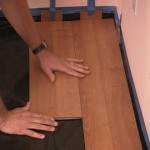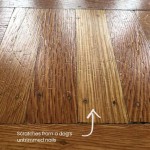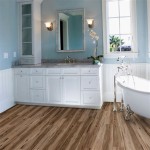The Enduring Appeal of High-End Cork Flooring
Cork flooring, a sustainable and versatile material, has experienced a resurgence in popularity, particularly in the high-end market. No longer solely associated with bulletin boards and wine stoppers, cork has evolved into a sophisticated flooring option lauded for its unique aesthetic, comfort, and environmental benefits. High-end cork flooring represents a significant investment, but the payoff lies in its durability, natural insulation properties, and distinctive visual appeal.
The transformation of cork from a niche material to a sought-after flooring solution is driven by advancements in manufacturing, design, and finishing techniques. These innovations have resulted in cork flooring that is not only beautiful but also highly resistant to wear and tear, making it suitable for both residential and commercial applications. This article explores the key features, benefits, and considerations associated with high-end cork flooring, providing a comprehensive overview for homeowners, designers, and architects seeking a premium and sustainable flooring solution.
Sustainability: A Cornerstone of Cork's Appeal
Sustainability is a core characteristic that distinguishes cork flooring from many other options. Cork is harvested from the bark of the cork oak tree ( *Quercus suber* ), a species predominantly found in the Mediterranean region, particularly in Portugal and Spain. The harvesting process is carefully managed and does not harm the tree. The bark is stripped every nine years, allowing the tree to regenerate the bark and continue to grow and thrive. This regenerative harvesting method renders cork a truly renewable resource compared to materials like hardwood, whose harvesting involves deforestation and longer regeneration cycles.
The environmental benefits extend beyond the harvesting process. Cork oak forests play a vital role in biodiversity, providing habitat for numerous plant and animal species, including endangered ones like the Iberian Lynx. These forests also act as carbon sinks, absorbing significant amounts of carbon dioxide from the atmosphere, aiding in mitigating climate change. Choosing cork flooring, therefore, directly supports the preservation of these valuable ecosystems and the reduction of carbon emissions.
Furthermore, the manufacturing process of cork flooring typically involves minimal waste. Cork byproducts from other industries can be repurposed into flooring, further minimizing environmental impact. Many manufacturers also employ sustainable production practices, such as using water-based adhesives and low-VOC (volatile organic compounds) finishes, which contribute to healthier indoor air quality.
Unparalleled Comfort and Performance
Beyond its environmental advantages, high-end cork flooring offers exceptional comfort and performance characteristics. Its natural cellular structure gives it a unique combination of resilience and cushioning. This inherent elasticity makes cork flooring significantly more comfortable underfoot compared to harder surfaces like tile or concrete, mitigating the impact on joints and reducing fatigue, especially beneficial for those who spend extended periods standing.
Cork's cellular structure also contributes to its excellent thermal insulation properties. It helps maintain a consistent room temperature, reducing the need for excessive heating or cooling, thereby lowering energy consumption and utility bills. The natural insulation also provides an element of sound absorption, reducing noise transmission between floors and creating a quieter, more peaceful environment.
High-end cork flooring often features advanced finishing techniques that enhance its durability and resistance to wear and tear. These finishes, which can include multiple layers of polyurethane or acrylic, protect the cork from scratches, stains, and moisture. Some manufacturers also offer pre-finished cork flooring with UV-cured finishes, which provide exceptional durability and resistance to fading.
Furthermore, cork is naturally antimicrobial, inhibiting the growth of mold, mildew, and bacteria. This makes it a hygienic choice for flooring, particularly in areas prone to moisture or where allergies are a concern. The natural antimicrobial properties also contribute to a healthier indoor environment.
Aesthetic Versatility and Design Possibilities
High-end cork flooring provides a wide range of aesthetic options, allowing homeowners and designers to achieve diverse design styles. The natural variations in cork's grain patterns and colors create a unique and visually appealing surface. These variations, ranging from light beige to dark brown, can be further enhanced through staining, texturing, and finishing techniques.
Cork flooring is available in various formats, including tiles, planks, and floating floors. Tiles offer flexibility in creating custom designs and patterns, while planks provide a more traditional wood-like appearance. Floating floors are easy to install and can be used over existing subfloors, making them a convenient option for renovations.
The design possibilities are further expanded by the integration of digital printing technologies. These technologies allow for the creation of cork flooring with realistic wood, stone, or tile patterns, offering the aesthetic appeal of these materials while retaining the comfort and sustainability benefits of cork. Custom designs and patterns can also be created to match specific design requirements.
High-end cork flooring can be seamlessly integrated into various interior design styles, from modern and minimalist to traditional and rustic. Its natural texture and warm tones create a welcoming and inviting atmosphere. It can be paired with a wide range of furniture styles and color palettes, allowing for creative and personalized design solutions.
The maintenance of cork flooring is relatively simple. Regular sweeping or vacuuming is sufficient to remove dust and debris. Occasional damp mopping with a mild detergent is recommended to maintain its cleanliness. Avoid using harsh chemicals or abrasive cleaners, as these can damage the finish. With proper care, high-end cork flooring can maintain its beauty and performance for many years.
Choosing the right type of cork flooring requires careful consideration of several factors. The intended use of the space, the level of traffic, and the desired aesthetic are all important considerations. Consult with a flooring professional to determine the appropriate thickness, finish, and installation method for your specific needs. A well-informed decision will ensure that your high-end cork flooring provides lasting beauty, comfort, and sustainability.
The cost of high-end cork flooring is generally higher than that of standard cork flooring, but it is often comparable to that of other premium flooring options, such as hardwood or engineered flooring. The higher cost reflects the superior quality of the materials, the advanced manufacturing techniques, and the enhanced durability of the product. While the initial investment may be higher, the long-term benefits, including reduced energy consumption, improved indoor air quality, and increased home value, can make high-end cork flooring a cost-effective choice in the long run.

Usa S Best Cork Flooring Wall Tiles Underlayment And More

Advantages Disadvantages Of Cork Flooring Floorings

Waterproof Cork Flooring Look

Save A Tree Go Green With Cork Flooring Icork Floor

Quality Cork Flooring St Louis Champion Floor Company

Best Cork Flooring Fusion Icork Floor

Cork Flooring Ll

2024 Cork Flooring Installation Guide Cost Of Modernize

Cork Flooring Ll

Cork Flooring Supply Installation London Hard Floor Fitting Cavendish Devere
Related Posts








